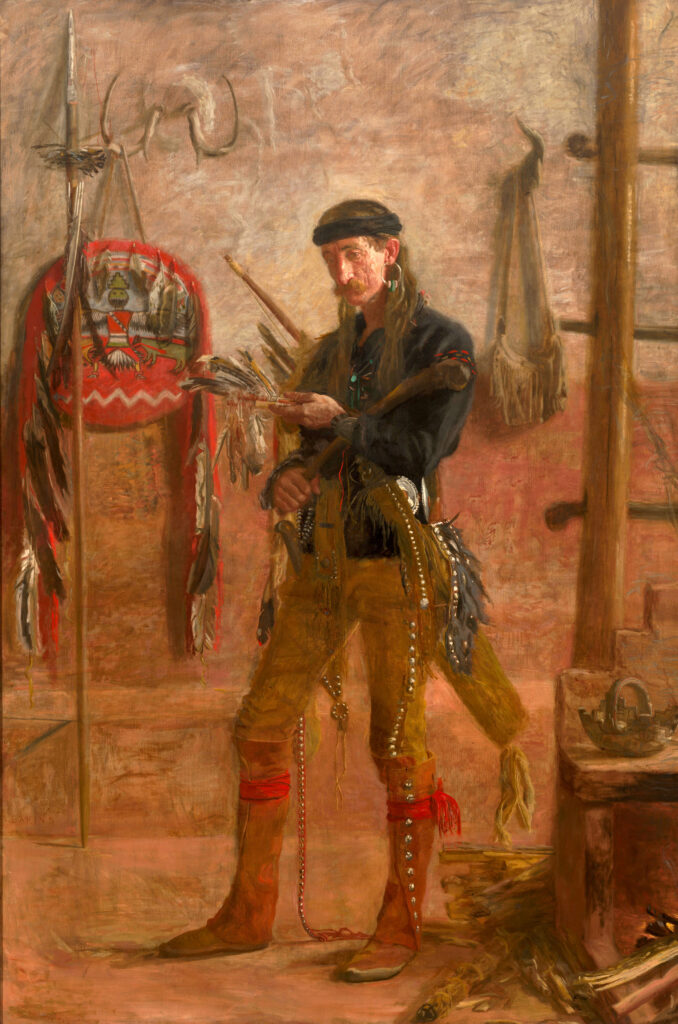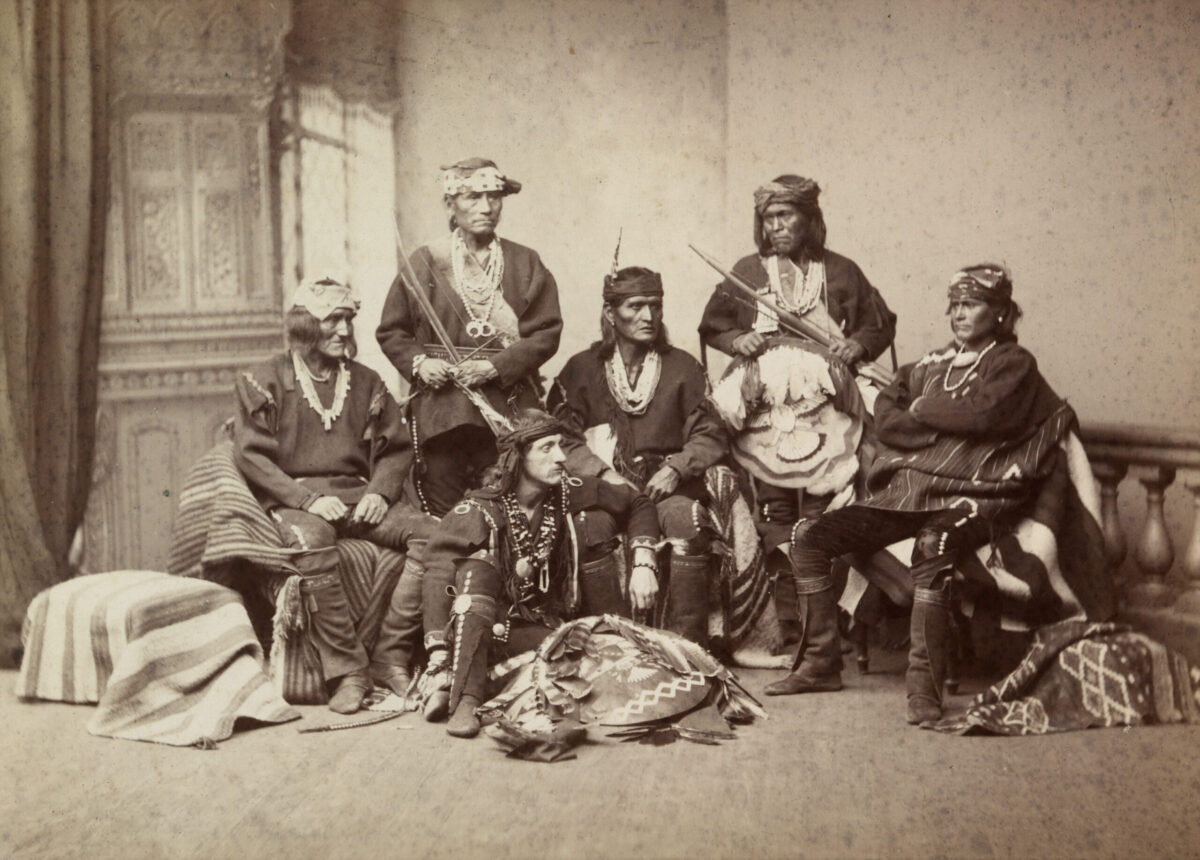By the early 1880s encounters with eastbound American Indian delegations arrayed in furs, buckskins and eagle-feather warbonnets had become rather commonplace, their arrival in Washington, Chicago, Baltimore, Boston and other big cities provoking curious glances and photo ops. Easterners might spot Sac and Foxes on museum visits, Osages sharing lobster with congressmen or Sioux entering the White House grounds to speak with the “great white sachem.”
One cool night in March 1882 at Harvard’s Hemenway Gymnasium gathered New Englanders watched with rapt attention as Zunis filed out from beneath the balcony to center stage. Turbaned heads held high, clad in moccasins, leggings and navy pullover shirts bound with red sashes and dripping with shell-and-turquoise necklaces, the stoic quintet was a revelation to the Eastern audience members, whose idea of Indians was, as journalist Charles F. Lummis put it, “a hazy cross between a cigar-store wooden eikon [sic] and dime-novel scalp taker.”
The Zunis were priests of the Bow Society, a secretive order charged with the tribe’s welfare. Leading them, hushing the crowd in harangues of Zuni and English, was one of the oddest figures the elites had ever seen—a pale, long-haired man of delicate build dressed like the others but with the added flourishes of glittering conchos hammered from coins, resplendent garters, beaded bracelets, hooped earrings and a scalping knife in a flamboyant brass-buttoned sheath.
Aside from his mustache, he looked more Indian than his entourage. But Frank Hamilton Cushing had been born a quarter century earlier in Pennsylvania and raised in western New York. A sickly child who barely survived infancy, he’d grown to be a self-taught prodigy who, smitten by Indian lore, studied nature, learned to replicate arrowheads and birchbark canoes, and, at age 17, published his first scientific paper. Dropping out of Cornell University, he hired on with the Smithsonian Institution to curate exhibits under the tutelage of Western explorer and geologist John Wesley Powell, founding director of the national museum’s Bureau of Ethnology. Powell dispatched “Cushy,” as colleagues knew him, to New Mexico to live among Pueblo dwellers, hunt for relics and “lost civilizations,” and publish his findings.
While carrying out Powell’s mandate, Cushing unexpectedly “turned Zuni,” learning their complex tongue, absorbing their lifeways and recording their rituals. To gain entrance into the Bow Society, he collected a Havasupai scalp—presumably from a corpse. Philosophically tolerant, a quick study in linguistics and proficient in herbal cures, he was soon adopted into the tribe, the Zuni dubbing him Tenatsali, or Medicine Flower.
By the spring of 1882 he’d been living among the Zunis two years. As promised, he would now share his world with his hosts. Coincidentally, Tenatsali also needed cash to further his work for the bureau. So, in a timely ploy arranged with Powell and journalist Sylvester Baxter of the Boston Herald, he would both raise funds and, hopefully, escape proffered Zuni matrimony by wedding longtime fiancée Emily Magill come July.
This night in March the crowd quieted, and the lights dimmed. On a signal from Tenatsali his quintet launched into a heel-and-toe stomp dance, drums pounding to wails, chants, keening war cries and the rise and fall of feathered prayer sticks.
At the final thud Cushing took the podium to explain to attendees—in English and Zuni—what they had seen, describing tribal land and the mode and habits of the people. Then, with dramatic flair, the white Zuni lapsed into bilingual fragments of indigenous poetry that began “May-a-wee! May-a-wee!” (“Spirit of the Antelope. Spirit of the Antelope!”)
“He sang in a sweet voice,” fellow ethnologist John Gregory Bourke recalled of Cushing, “a little bit tremulous from nervousness.” There followed more dances, drumming, creation tales and courtship chants, all translated by Medicine Flower. The exotic presentation ended with a Zuni elder beseeching the Great Spirit for a bountiful harvest for their kind American hosts. Bostonians leaving the Harvard campus that night gushed over the spectacle they’d witnessed and opened their financial coffers to Cushing.
“It was,” Lummis wrote, “the ‘cleverest’ thing that has ever been devised and carried out by a scientific student anywhere.” Cushing showed he could “out-Zuni the Zunis,” wrote Baxter in Harper’s New Monthly Magazine. As spring lapsed into summer, the entourage encored at Massachusetts’ Wellesley College and in churches, clubs and theaters in Salem and Philadelphia, feasting on “oysters and frozen pudding and cake”—a far cry from such traditional dishes as fried maize tortillas stuffed with roasted locust. In one reported side venture the Zunis waded into the Atlantic Ocean to draw sacred seawater from the “Ocean of Sun Rise.”

On his return to Washington with the Zunis, Cushing was the talk of the town. Artist Willard Metcalf “took notes on all that occurred” and sketched Medicine Flower in full regalia. Portraitist Thomas Eakins rendered him in oil among Zuni accoutrements. Cushing also sat for a portrait by Powell’s staff photographer John Karl Hillers. By day the celebrated ethnologist labored at his desk, polishing his field notes into lyrical books on the Southwest, Zuni life and esoteric religious rites, their eventual publication opening a rift between him and his adoptive Zunis. By night he and the priests performed. Few knew he was plagued with tapeworm and diverticulitis, prompting hospital stays, stomach pumping and fad diets that left him gaunt and debilitated.
Meanwhile, his effective advocacy on behalf of the Zuni thwarted a brewing land-grab scheme by Senator John A. Logan of Illinois, eventually resulting in Cushing’s permanent recall to the Smithsonian, where he transcribed Cheyenne sign language before venturing south to research extinct Calusa settlements along Florida’s southwest coast. Battling illness, mosquitoes and the sweltering heat, he managed to write a landmark journal and unearthed a cache of masks, figurines and pottery that remain on display in the Marco Island Historical Museum.
Cushing’s work and life came to abrupt end in the spring of 1900 amid a research trip to Maine. One evening while dining, he swallowed a fish bone that scored his throat. The resulting hemorrhaging claimed his life on April 10. He was only 42. Some Zunis deemed it retribution for his having broken tribal taboos by revealing their sacred rituals. Others wept.
Contemporary Zunis reportedly remain wary of anthropologists. Artist Phil Hughte’s cartoon collection A Zuni Artist Looks at Frank Hamilton Cushing gently parodies the tribe’s ambivalence regarding his subject’s intrusion into Zuni culture—seen either as an act of betrayal or as a sincere attempt to understand it.
Though in retrospect his methods pose ethical dilemmas, Cushing—the first known anthropologist to have interpreted tribal peoples cross-culturally as a “participant observer” and to have employed relativism to find value in their world—is regarded by many as a brilliant researcher ahead of his time. He published more than a dozen books, and universities still teach his immersive method as “reflexive anthropology.” Thus, from academe’s halls to the American West there remains a unique historical niche for Frank Hamilton “Medicine Flower” Cushing.






